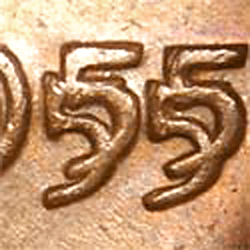|
"Making Cents"
The Signal
Saturday, November 25, 2006
| I |
Coin dealer and author Q. David Bowers received a call from a man in New York City that summer, offering him a roll of these doubled dies. Bowers checked with other dealers and found they had recently been offered the same coins and were paying up to $50 apiece.
This was a Mint error that was discovered at the Mint but was allowed to pass because there was a shortage of cents in the area due to the effects of hurricanes Connie and Diane that had recently left a swath of destruction along the Atlantic Coast.
Normally, when such errors are discovered, production is halted and as many of the error coins as possible are retrieved and destroyed.
Since 1955 doubled dies are so distinctive, their prices have zoomed over the years. A brilliant uncirculated specimen (Mint State-65 Red) sold in 1998 for $16,000, and the same coin was sold three years later for $35,000. Average, slightly circulated specimens (called XF) sell for $400 to $500 or more. Prices accelerate as the conditions rise above MS-60.
Earlier in 1955, it was announced that the San Francisco Mint would be closed for regular coin production later in the year. As a result, only 44.8 million cents were produced ‹ a very small number compared to the hundreds of millions normally minted.
Many speculators hoarded as many as they could buy. New York coin dealer Robert Friedberg managed to acquire 7 million of the 1955-S cents. They were stored in a vault and not discovered until he died several years later. The price of uncirculated rolls of 1955-S cents rose to about $10 in 1955, and rose steadily in subsequent years. When the hoard became known, they were quickly absorbed by dealers, collectors and investors. Today's price is about $24 per roll.
The only other coins minted in 1955 at San Francisco were dimes, and a total of only 18 million were released ‹ again, a relatively small number compared to other years and other mints. These, too, were hoarded, but no hoard as large as the Friedberg hoard was known ‹ due to the unit cost, no doubt. However, as early as 1960, Manchester Coins of California was offering hundreds of rolls for sale in its weekly ads in the trade publication "Coin World" for $10 per roll. Today, rolls are advertised at $65.
The other issues of 1955 have become investor quality coins ‹ either for gem uncirculated specimens or for uncirculated rolls. These include the 1955 nickels, which had a low mintage of 7.8 million. The 1955-D quarters had a mintage of 3.182 million, the lowest mintage since 1940. The 1955 half dollar has a low mintage of 2.49 million, which is the lowest mintage in the Franklin half dollar series.
Proof sets issued early in 1955 came in a small, square box with each of the five coins ‹ 1 cent to 50 cents ‹ in a small cellophane bag stapled together at the top. By mid-year, the Philadelphia Mint had switched to a sealed, flat pack of cellophane with a small Mint seal included. These are known as "flat packs" and sell today for about $150 per set ‹ although most of the boxed sets have been dismantled and the coins placed in other types of holders. Many flat packs have also been dismantled because the cellophane tends to crack and allow air to tarnish or spot the coins.
One interesting doubled die was discovered some years later, known as the 1955 doubled-die reverse where the motto ‹ E. Pluribus. Unum ‹ was clearly doubled. The dots between the words appear as a small figure-8s. This coin alone retails for $50.
Collectors who were active in 1955 had a field day, since most of these coins ‹ except the doubled-die cents ‹ were fairly easy to acquire from local banks. Those who did buy quantities of these coins have done very well, as investments go. I was able to buy rolls of 1955 nickels from my local bank and sold them for five to 10 times their face value over the next few years. Had I the funds, I surely would also have purchased rolls of the 1955 half dollars ‹ which did not start to appreciate until the early 1960s. Today's retail price per roll is $475. And I have never found one in circulation.
Dr. Sol Taylor of Sherman Oaks is president of the Society of Lincoln Cent Collectors and author of The Standard Guide to the Lincoln Cent. Click here for ordering information.
©2006, THE SIGNAL · ALL RIGHTS RESERVED.

![[Most Recent Quotes from www.kitco.com]](http://www.kitconet.com/images/quotes_special.gif)

